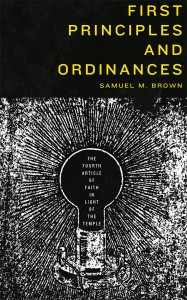 Sam Brown has written an important and beautiful book. Every Mormon serious about deepening their understanding of their most fundamental commitments should read it, and any Mormon who feels adrift in the institutional church will find resources sufficient to stoke the fires of faith anew. It is also a fantastic introduction to the fundamentals of the Mormon faith for anyone new to Mormonism.
Sam Brown has written an important and beautiful book. Every Mormon serious about deepening their understanding of their most fundamental commitments should read it, and any Mormon who feels adrift in the institutional church will find resources sufficient to stoke the fires of faith anew. It is also a fantastic introduction to the fundamentals of the Mormon faith for anyone new to Mormonism.
You read the book and feel that this is, of course, familiar ground. That’s because the book’s focus is the first principles and ordinances of the gospel—faith, repentance, baptism, and the Gift of the Holy Ghost. But it feels as if you are beginning your own spiritual journey into Mormonism for the first time. Brown is not an iconoclast. He is unreservedly devout. But he is also quietly determined to overturn the soils of intellectual habit that have allowed both affirmations and criticisms of belief and practice to ossify. You won’t hear anything unorthodox in this book, but you will hear things like you have never quite heard them before. Brown is entirely genuine, uncannily wise and consistently insightful, and he is intimately honest. He also writes with exceptional clarity and grace. His criticisms of lazy habits we sometimes adopt to make the journey of faith more comprehensible to us and maybe just a little too easy are gentle and inviting, rather than shrill or self-righteous, and he pulls this off because he exposes his own vulnerabilities and because he is eminently successful in showing us better ways to think about these principles and ordinances.
Brown’s basic thesis is simple but profound. Everything that matters in the gospel matters not just because it saves our individual souls but because it builds community, strengthens relationships, and helps us to heal the wound of individuality in the bonds of family and friendship. We matter because we matter to the Lord but also because we matter to each other. And faith and repentance and the ordinances that join us into the family of Christ—baptism and the Gift of the Holy Ghost—are not merely intended to save us so much as they are designed to transform us into people capable of loving ourselves, loving our friends, and ultimately loving our enemies.
He is intent on helping us to understand just how responsible we are for our faith. Faith is not the inevitable and natural result of a kind of rational persuasion based on spiritual facts that we can no longer disbelieve. Facts, he reminds us, after all are “usually only partly reliable simplifications of a much more complex reality” and as such they never stand alone, apart from the context of lived experience. Being religious, then, is not a matter of cornering the market on truth or expending our energy trying to make rational sense of religion’s claims just so that we can announce to others that we are right about things or to persuade others, but rather committing ourselves to putting beliefs to work in our relationships. This might be somewhat deflating news to believers, especially to those for whom the battles over being right have consumed the greatest amount of their energy, time, and focus. It’s as if we have wanted to make God and even the entirety of the Restoration so rational, so clear, and so persuasive that faith is no longer even necessary; belief, we imagine, is simply the inevitable outcome of an exposure to a sufficient amount of information, which is to say that it isn’t faith at all but rather rational conviction. The problem with positioning faith in this way is that once a new set of facts comes into view, we either deny them or our faith collapses. In both cases, we have failed because we never understood “the role of choice and conscious commitment in religious belief.” We mustn’t forget that doctrine and faith are different things, he reminds us. Faith, he says, “is a lived action made real in the world.” Faith, in other words, is trust in something we want to be true, so much so that we work for it to become a reality.
Of course that means that it takes as much faith to actively deny God as it does to actively proclaim him. Brown is not arguing, however, against the possibility of revelation or that truth is merely what we imagine it to be. Far from it. Indeed, he opens with an utterly compelling account of his own waywardness as a young teenager and his piercing discovery of God’s reality and presence in the midst of his ordinary relationships. He suggests, in fact, that it is in the context of daily life and daily relationships where God most commonly reveals himself. But his point is simply that we shouldn’t pretend that these manifestations happen independent of what we have earnestly worked to make possible or wanted. Perhaps most importantly, we should acknowledge our responsibility to work to sustain their significance in our lives and to increase the likelihood of continued revelations.
It strikes me that this insight is especially important when we encounter turbulence in our testimonies or in our relationship to the institution of the church. Like any committed marriage, he writes, when we are vexed or stressed, if we want our relationship to God and to the church to succeed we will have to learn to acknowledge the challenge but place it into the broader context of our “entire relationship with the church. If the stress is particularly severe,” he notes, “I will need to actively supplement those negative experiences with many positive ones.” For him, the positives are found in his sensitive and beautifully described observations of the most elemental practices of our religion, in hymns, in prayers, in the laying on of hands, in the sacrament. And all of these experiences are in the context of relationships with others. The journey of faith should never place us on a lonely path but should instead bring us into nurturing relationships with God and with our brothers and sisters. This is because “faith is an active relationship that requires attention, effort, and, as Alma notes, nourishment.” It shouldn’t deflate us to realize that faith is, at least in part, what we make of it, what we are willing to do with belief, and how committed we are to transforming ourselves and our relationships. I say this because even though it might be easier to imagine God or the church are chiefly responsible for filling us with the right dose of passion to get us through, remembering that faith is a commitment and a choice can be deeply empowering and transforming, especially because it gives us the greatest access to Christ’s atoning power.
Ultimately, then, belief isn’t merely about information, and working through crises of belief isn’t merely about getting more or better information. Religious practice in the community of fellow brothers and sisters affords something even more profound than a knowledge of the truth that we can summarize and easily communicate; it affords experiences of love, community, and collective striving that provide knowledge, but a kind of knowledge that often goes beyond words. We do need to try to express it in language, but it can only be adequately captured in the experience of the whole person. If he is right to say that “deep thinking happens with the whole soul,” then surely intellectual work and fact gathering are a mere fraction of what is required of us. Faith is best understood as “relationships that are strong enough to trust into transformation.”
There is much more to say about this marvelous book. I will only add that the entirety of his perspective is saturated by a profound understanding of the ordinances and teachings of the temple, for it is there, as I have also expressed, that Mormonism teaches the most profound lessons about the relational dimensions to our redemption, what he calls our “entanglement.” There “we use our bodies and our minds to participate in rituals that create and sustain a community strong enough to overwhelm death.” Resurrection without community, he argues, was for Joseph Smith an insufficient solution to the problem death poses. Death is not only an end of a life but a separation and radical isolation of the individual. The love we feel for the dead, the pain we feel at separation, and the longing we experience are all expressions of one of our deepest and most sacred yearnings for spiritual communion with others. The greatest experiences of God’s love are not just individually had but often facilitated and enhanced by the quality of our relationships with one another. And the temple reminds us that the intimate feelings of community—whatever we might achieve in marriage and family or in the ward family—must be extended and stretched broadly enough to reach the entirety of the human family.
I must confess that I consider Sam Brown a good friend, someone whom I have admired for some time, so this isn’t an entirely objective review. But many of the reasons I have admired him are on full display in the book. As I said, he is entirely genuine and his conversion to the gospel profound. Because his path to full commitment to gospel living has not been an easy one, you read with the confidence that his is a truly organic fidelity. There is no pretense in him. And he is exceptionally bright. His mind ranges widely, connecting his Mormon thinking to broader conversations in medicine, to contemporary debates about God, and to history. He models a civility and warmth of discourse that we could use much more of in Mormonism today. He deftly and gently suggests alternatives to what he thinks are less productive ways of thinking about the gospel without once denying the good that those ways of thinking can or have been intended to produce. His is a fraternal discourse, one that invites discussion and stimulates growth without feeling the need to call out his enemies or to artificially elevate himself. Lord knows, I suspect, that we could use more such thinkers in the church. Sam Brown is a gift.











